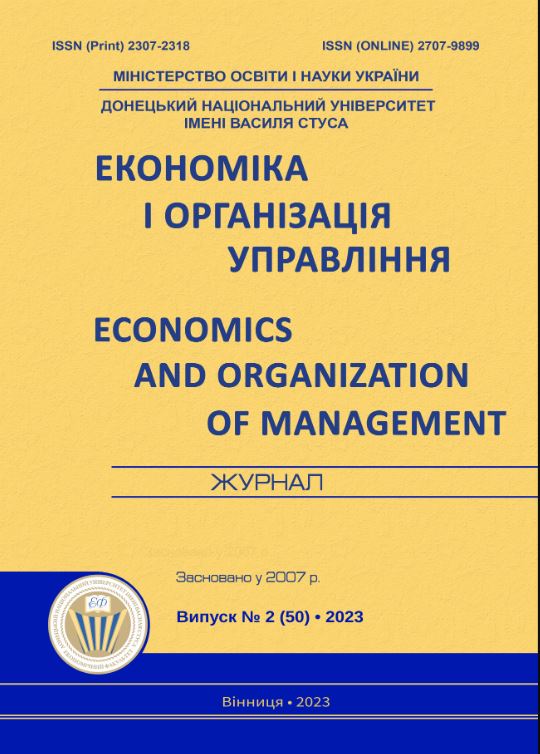International economic relations of China and the USA in the context of the struggle for global leadership
DOI:
https://doi.org/10.31558/2307-2318.2023.2.7Keywords:
international economic relations; trade wars; export; import; global economy; economic competitor; competitive leadership; globalizationAbstract
The developing crisis in trade and economic relations between the US and China, which has taken the form of a trade war between the two countries, may have hardly predictable consequences for both countries and the entire global economy. This is due to both the scale of the economies of the United States and China (the first and second largest in the world by GDP - respectively, USD 20.5 and 13.4 trillion at the current exchange rate according to the International Monetary Fund) and their role in world trade.
It has been determined that over the past almost 20 years of active economic cooperation, the US view of China has evolved significantly - from perceiving it as a close and one of the leading economic partners to perceiving it as a major economic competitor and even as a major strategic threat. This is explicitly stated in the US National Security Strategy.
It is determined that foreign economic relations between the United States and China have entered a new stage, which is significantly different from the previous almost twenty-year period of active interaction and growing interdependence. As China becomes stronger, the factor of increased competition is becoming predominant in these relations. The role of the scientific and technological component is becoming decisive. Most important in this situation is the fact that the globalisation of the world economy, driven by scientific and technological progress, including the close intertwining of the US and Chinese economies, is in conflict with the national interests of both countries, which are seeking to strengthen their positions and role in the world economy.
In general, foreign economic relations between the United States and China in the twenty-first century can be described as very ambiguous and controversial. The countries have come a long way from open conflict to relatively stable political and economic cooperation. The United States, seeking to maintain its status as the most influential country in the world, is hindering the development of those countries that could compete with it, as well as certain projects that could significantly accelerate the progress of competing countries. The implementation of China's One Belt, One Road strategy will be in a difficult position if the United States obstructs it. There is no doubt that this initiative has a significant impact on current relations.
References
Fajgelbaum P., Khandelwal A. The economic impacts pf the US-China trade war. URL: https://www.nber.org/system/files/working_papers/w29315/w29315.pdf.
Blinken A. An Enduring Vision for Central Asia. Brookings Institute. Washington D.C. 2015. 31. URL: http://2009-2017.state.gov/s/d/2015/240013.htm.
Denyer S. China takes a jab at U.S. as Europeans back Asian Bank. The Washington Post. 2015. 19 March.
Senior State Department Officials Preview Secretary Kerry’s Trip to Paris and Beijing. Special Briefing Via Teleconference. 2014. 7 November. URL: http://2009-2017.state.gov/r/pa/prs/ps/2014/11/233827.htm.
Huang Y. The U.S. – China trade war has become a cold war. URL: https://carnegieendowment.org/2021/09/16/u.s.-china-trade-war-has-become-cold-war-pub-85352.
Remarks by President Obama and Prime Minister Abe of Japan in Joint Press Conference. The White House. Washington D.C. 2015. 28 April. URL: https://Obamawhitehouse,archives.gov/the-pressoffice/2015/04/28/remarks-president-obama-and-prime-minister-abe-japanjointpress-conference.
Biswal N. Central Asia in a Reconnecting Eurasia/ Remarks at Center for Strategic and International Studies, 2015. 12 May. URL: http://2009-2017.state.gov/p/sca/rls/rmks/2015/242232.htm.
Hass R., Denmark A. 2020. “More pain than gain: How the US-China trade war hurt America”. Brookings, August 25, 2020. URL: https://www.brookings.edu/blog/order-fromchaos/2020/08/07/more-pain-than-gain-how-the-us-china-tradewar-hurt-america/.
Khan R., Mehmood Z.H. Revesing the US-China trade war: a strategic assessment. URL: file:///Users/user/Downloads/cepik,+AUSTRAL+V.10+N.19+(EN)-181-198.pdf.
Blinken A. An Enduring Vision for Central Asia. Brookings Institute. Washington D.C. 2015. 31 March. URL: http://2009-2017.state.gov/s/d/2015/240013.htm.
Amadeo K. 2021. “The Real Reason American Jobs Are Going to China”. The Balance, April 30, 2021. URL: https:// www.thebalance.com/u-s-china-trade-deficit-causes-effects-andsolutions-3306277.
Wells A. Building Regional Architectures. 2018. 28 August. URL: https://www.state.gov/p/sca/rls/rmks/2018/285557.htm.
The White House, Remarks by president Trump on the administration ‘s national security strategy. 2017. 18 December. URL: http://www.whitehouse.gov/briefings-statements/remarks-president-trumpadministrations-natio nal-security-strategy/.
Testimony to the Senate Armed Services Committee by Acting Secretary of Defense Patrick M. Shanahan. 2019. 14 March. URL: https://www.armed-services.senate.gov/imo/media/doc/Shanahan_03-14-19.pdf.
Browne R. Top US General: China Will be “Greatest Threat” to US by 2025 // CNN. 2017. 27 September. URL: https://edition.cnn.com/2017/09/26/politics/dunford-us-china-greatestthreat/index.html.
State Press Availability With Secretary of Defense James Mattis, Chinese Politburo Member Yang Jiech I, and Chinese State Councilor and Defense Minister General Wei Fenghe. 2018. 9 November. URL: https://www.state.gov/secretary/remarks/2018/11/287279.htm.

